
Romanian Athenaeum (Ateneul Român)
Introduction
Humanities in Romania? I wasn’t expecting this connection to happen. As a westerner, my knowledge of Eastern European History is dismal (Dracula is still on my bookshelf unread).
After reading a few books on Romania, I began to realize how much rich history and lore this small country held. Folk tales, traditions, religions, and conquest were behind nearly every story I read. Like every lost treasure, the Romanian Athenaeum was a gem buried behind a rusty padlock of foreign languages and undigitized manuscripts.
Through much dusting, digging, and sweeping, I found the key to this treasure chest in the form of a long and lengthy document detailing the history behind this beautiful building. Completely in Romanian, and not a single word in Engligh, I painstakingly google translated my way through each paragraph. What I discovered was more than just a beautiful building; it was a puzzle piece in my quest to understand, restore and revive the Humanities.
Early Society
In 1865, 23 years before construction on the Athenaeum began, a Romanian named Constantin Escaru returned from a tour through France, Italy and Greece. Inspired by the cultural knowledge and beauty of the neo-classical movement (notably the 37AD Athenaeum in Lyon and the 135 AD Athenaeum School in Rome), he founded the Athenaeum Society alongside several other Romanians.
“The cultural activity of the Romanian Athenaeum was to manifest itself in all forms and by all means, especially "through research, studies, communications, through courses and public conferences; through publications, through artistic exhibitions and musical auditions; through meetings and theatrical performances; through the establishment of public libraries, collections and art galleries; through the awarding of prizes for works regarding the purpose of the society"
(Cultură şi Civilizaţie, Conferinţe ţinute la tribuna Ateneului Român, Antologie, note şi prefaţă de Gheorghe Buluţă, Ed. Eminescu, Bucureşti, 1989, pag. 331.)
4 years prior in 1861, the kingdoms of Moldova and Wallachia united as the Kingdom of Romanian, heralding long recorded peace in the region’s entire modern history. The enlightenment shortly flowed through from the neighboring European countries of France, Italy and Germany. Romanians now had the freedom and the intellectual ability to engage in conversations about philosophy, architecture, and science.
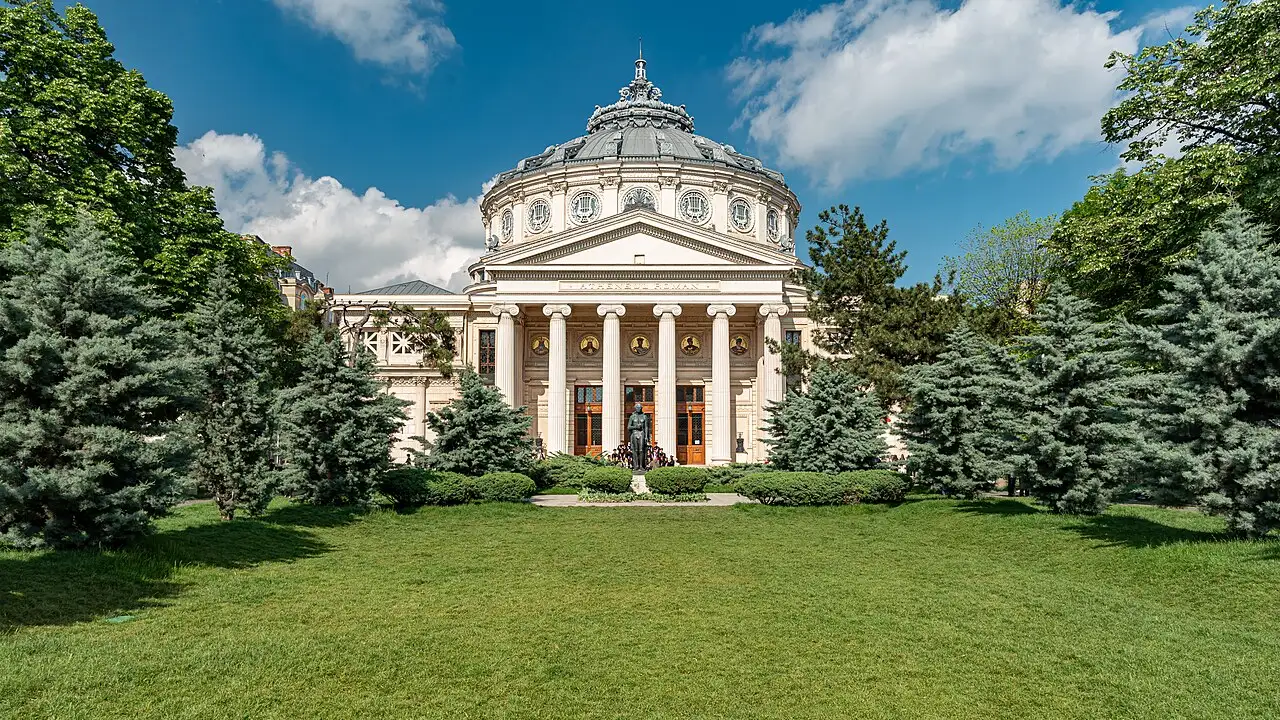
Societies around every sphere or knowledge were formed within the decade after unification, among them our Athenaeum Society. The desire from the people was so great, that for the society’s first public presentation in 1865, over 600 individuals were present.
For the next 20 years, the society would host presentations and publish periodicals. Locations for the presentations would vary between city buildings and supporter estates. Initial demand was so large that space would fill up and people would turn away from the lack of room. This led to a sudden decrease in attendance, causing the society to begin plans for their own private space.
What does Athenaeum Mean?
It derives from the Greek Athenaion, or Temple of the goddess of wisdom, Athene. During the Neo-classsical movement / period of enlightenment, western scholars used the name to denote institutions, libraries, and periodicals devoted to the study of literature, philosophy, and science.
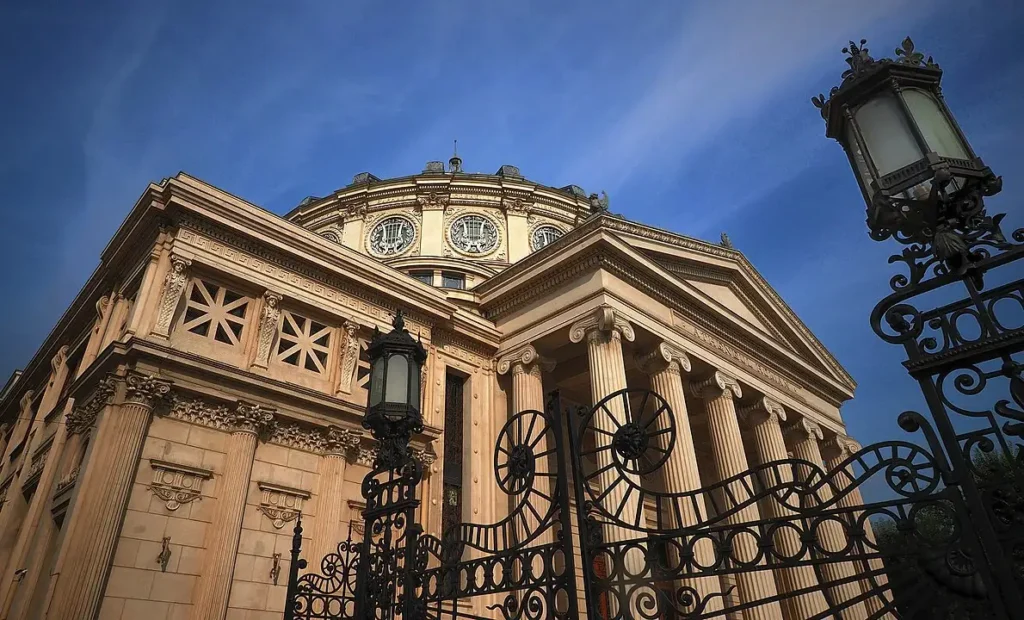
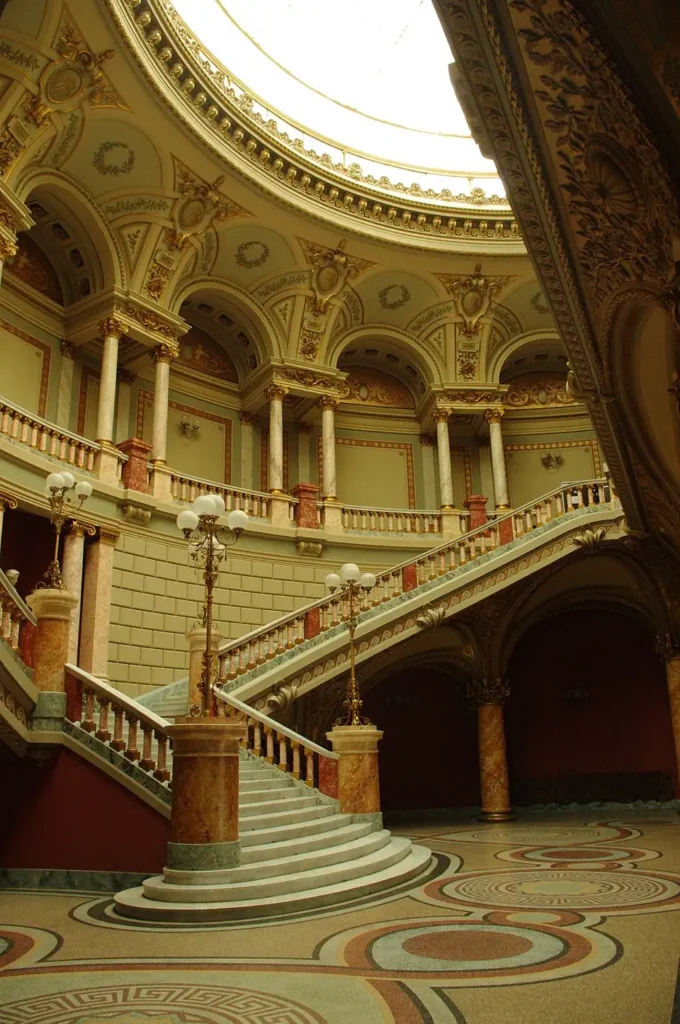
Architecture
The Building
Construction on the Roman Athenaeum began in 1886 under the supervision of famed architect Charles Garnier, the mastermind behind the neo-classical achievement called the Paris Opera House. While finishing up on the National Bank of Romania, Garnier was approached to design the Athenaeum by Escaru who shared a mutual love for the simplistic, yet elegant themes of Neoclassicalism.
Due to a strict budget, the site chosen was not in the desired city center, but further north in an unfinished equestrian estate. Contemporary techniques for fire prevention and earthquake resistance, and modern materials like steel rafters were utilized to reinforce the neoclassical facades and central dome which symbolized the vogue Greco-Roman philosophies of learning and wisdom.
Notable Architectural Details
Neoclassical examples of the Roman Athenaeum include:
- Triangular pediments reminiscent of Greek Temples;
- 8 Exterior columns at 12 meters in height are imitations of the Erechtheion in Athens, Greece.
- The Tripod towering above the great circular dome is modeled after the Monument of Lysicrates (Demosthenes Lantern) in Athens. This was a prize awarded to ancient Greek in statewide competitions for poets and artists.
- Above the entrance are 5 medallions of notable Romanian, Wallachian, and Moldovan voivodes:
- Alexandru cel Bun,
- Neagoe Basarab,
- Vasile Lupu,
- Matei Basarab
- King Carol I
Architectural Style
While Neo-classicalism began at the end of the 17th century, it took several decades for styles to trickle down from France and Rome to Eastern European countries such as Romania. While the Athenaeum was built during the Neo-classical period, elements of Baroque and Rococo phased out to a more strict and symmetrical sense as they adapted to contemporary neo-classicalism.
Three particular techniques employed in the Athaneum reflect the Baroque and Rococo themes that were slowly phased out for the prominent Neo-Classical style. Pink stucco marble columns are capped with traditional iconic capitals; carrara marble double-staircases which twirl down from the playhouse are muted against the pastel green and yellow walls. And finally, the Dome’s prominent proportion to the rest of the building, a baroque tactic used in Rome when space wasn’t readily available, but dynamic contrast allowed larger-than-life optics.
The Romanian Fresco
Inside the concert hall, a grand fresco circumferences the room. Painted by Costin Petrescu, it took over 30 years for the society to initially proceed. Fresco or canvas, paneled or contiguous, no consensus could be made between the board and Petrescu (including his requested 80,000 lira salary). Finally in 1933, convinced by Petrescu’s previous national works during this waiting period, the board approved his design: a contiguous fresco depicting historical Romanian scenes. It took Petrescu 5 years to complete the 75m long painting, where he talked with historians and presented sketches for total accuracy.
Petrescu’s dedication to retaining the old craft of fresco painting reflects the importance of traditional trades in Romania, a devotion many Romanians maintain today.
During the communist regime, red velvet and wooden boards were placed over the front medallions and the whole fresco from 1948-1966 to hide the rich Romanian history and suppress any creative output.
Videos
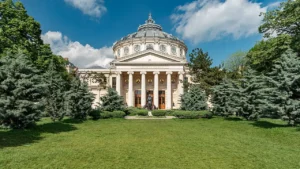
Lecția de Patrimoniu. Ateneul Român – un templu al culturii
Soprana Irina Baianț: Concert extraordinar la Ateneul Român I Un regal de muzică, emoție și eleganță
History of the ROMANIAN ATHENA | Interior and Fresco

Conclusions
For the next hundred years up to this present day, the Romanian Athenaeum became the cultural center for the humanities, hosting art salons, orchestras, galleries, and lectures. Through the prosperous peace of the late 19th century, a society devoted to promoting thought and innovation was born to a nation full of pride and hope. It reminds me of the National Geographic Society which was founded just a few decades later for the purpose of “organizing a society for the increase and diffusion of geographical knowledge.”
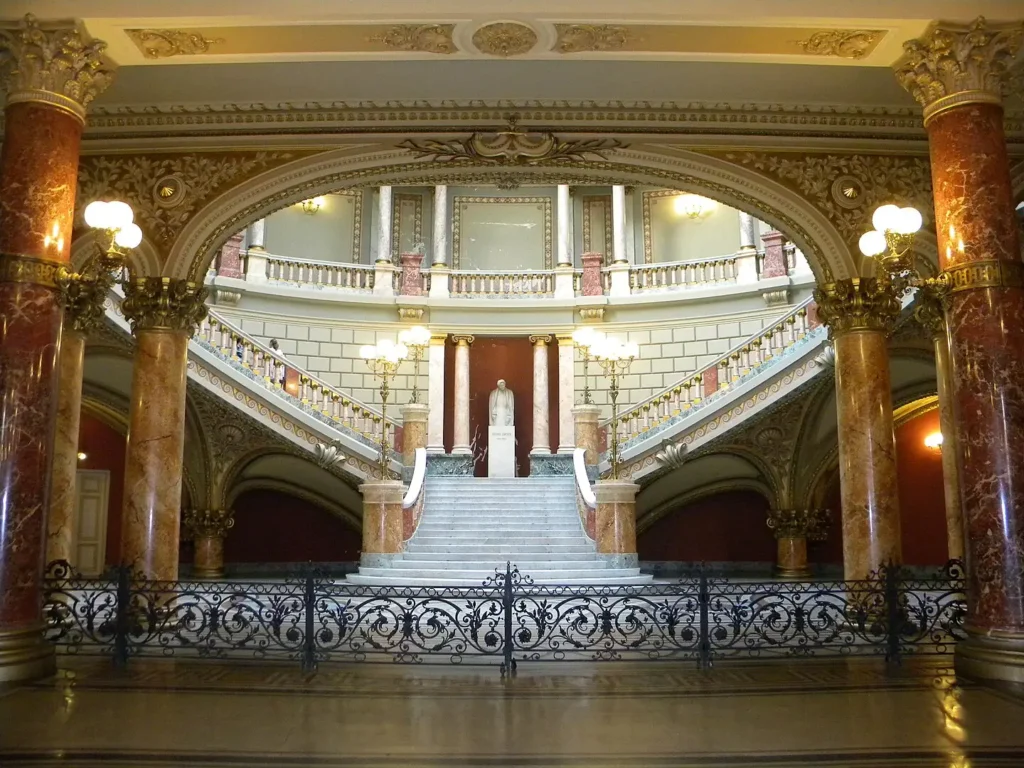
I find it fascinating to see two distinct cultures (Romanian and American) seek out the same desires. Humanities are about stories and learning. They are about communication and emotion.
As Christians, these pathways demonstrate the creativity and sovereign will of God. Our desire to learn and seek connections are communicable traits of the Father. We seek purpose and meaning behind our conversations (Psalm 133:1), and we learn from those memories and interactions recorded throughout history.

References
MERCIU, Florentina-Cristina, et al. “Visual Imagery and Construction of Territorial Identity through Iconic Buildings. Case Study: The Romanian Athenaeum.” Territorial Identity and Development, vol. 5, no. 1, 10 Sept. 2020, pp. 37–46, https://doi.org/10.23740/tid120203
“Constructiv.ro.” Archive.org, 2025, Interventii majore de restaurare la Ateneul Român. Accessed 4 Nov. 2025.
“Ateneul Român – 125 de Ani de La Inaugurare | Familia Regală a României / Royal Family of Romania.” Romaniaregala.ro, 2025, romaniaregala.ro/atitudini/ateneul-roman-125-de-ani-de-la-inaugurare/. Accessed 4 Nov. 2025.
B.C.U. “Carol I” Bucuresti, Atheneul Roman si cladirile antice cu dom circular, 1888.
“Prattler, 1988, Volume 51, Issue 4.” Prattler, May 1988. JSTOR, https://jstor.org/stable/community.35939335. Accessed 4 Nov. 2025.
today, Visit Bucharest. “Romanian Athenaeum.” Visit Bucharest, 25 Oct. 2019, visitbucharest.today/romanian-athenaeum/.
“Romanian Athenaeum, Bucharest (Romania).” Culture and Creativity, 11 Apr. 2024, culture.ec.europa.eu/cultural-heritage/initiatives-and-success-stories/european-heritage-label/european-heritage-label-sites/romanian-athenaeum.